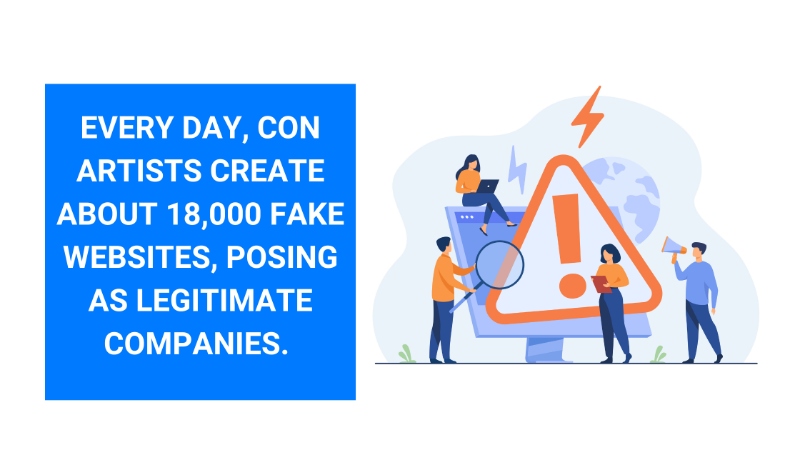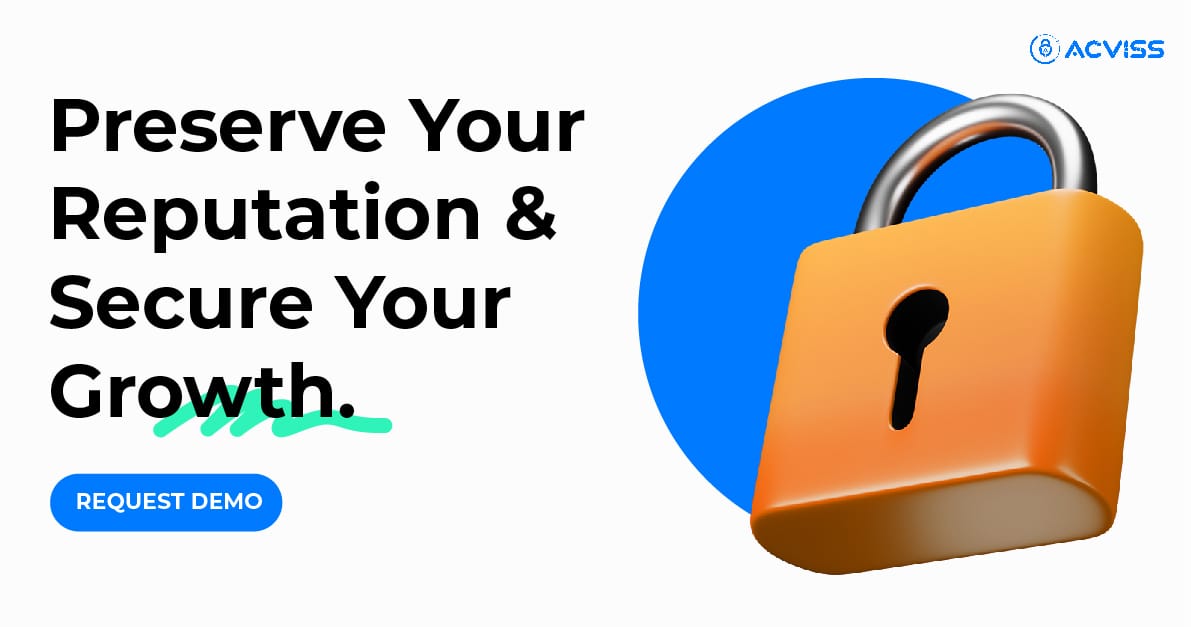Ultimate Guide on How to Take Down a Fake Website

Every day, con artists create about 18,000 fake websites, posing as legitimate companies. These websites are typically designed to deceive users into entering their personal information and/or financial information and downloading dangerous files that could endanger their computer system. Millions of dollars in repairs, theft, IT fees, and lost sales are a result of these websites, which also cost people and businesses a lot of money. A phoney website can also drastically harm the reputation of your company.
The Reason
Scammers on the internet, especially those who advertise bogus websites, may have a variety of sinister objectives. They could be:
- Requiring payment before transferring the phoney domain name to you;
- Stealing your consumers' business and providing them with false goods;
- Phishing for personal information such as passwords, account numbers, social security numbers, or medical records for their nefarious use or sale elsewhere, such as on the "dark web";
- Committing financial crimes—stealing money from you and your clients.
Identifying Fake Websites
The most popular method used by criminals to imitate a brand's website is a practice known as "domain name squatting." To do this, a domain based on an existing brand name must be registered. Once they're set up, scammers may use their new domain to mimic your branding (graphics, copy, etc.), sell bogus goods, or phish for personal information from unwary visitors. This is frequently done quickly and inexpensively.
Before using a website, take into account the following:
- Make sure you're on the official website by checking the domain name and conducting a search.
- Avoid making any payments through a bank transfer.
- If an offer seems too good to be true, such as steep reductions on expensive things, it probably is.
An internet con artist needs only to start by making a fake domain to start making money illegally off your brand. They may even directly imitate your website by misappropriating your company name, logo, and online materials.
This makes it simple to track your clients into thinking the site is yours when coupled with a domain that is almost an exact duplicate of your own. Then, these fraudulent websites might defraud your potential clients of their money and personal information. Your company is seriously at risk from cybersquatting, and the danger is only getting worse. According to a Statista report, a record-breaking number of domain name complaints disputing fraudulent websites were filed in 2020.
Must Read: Take Down Fake Apps from Play Store and App Store
Types of Website Scams You Should Know
1. Phishing Websites
Phishing websites are crafted to mimic legitimate sites, tricking users into entering sensitive data like login credentials, credit card information, or personal details. These scams often rely on fraudulent emails or messages to direct victims to the site.
Key Indicators:
- Slight misspellings in URLs (e.g., goggle.com instead of google.com).
- Generic greetings in emails or messages directing users to the site.
- Poor website design or lack of SSL certification (always look for “https://”).
How to Prevent:
- Verify the phishing attempt using resources like Google Safe Browsing.
- Report the site to phishing-specific databases such as PhishTank.
- Conduct a WHOIS lookup to identify the hosting provider and request a takedown.
2. Counterfeit E-Commerce Websites
Counterfeit e-commerce websites often clone established brands, luring customers with low prices on fake or non-existent products. These sites harm the brand reputation and defraud customers.
Key Indicators:
- Unrealistically low prices for high-value goods.
- Reviews that appear fabricated or overly generic.
- Limited or non-existent contact information.
How to Prevent:
- Use brand protection services like Truviss to monitor the digital landscape.
- File a DMCA notice with the hosting provider if your intellectual property is used.
- Submit a report to online marketplaces or payment processors to restrict their operations.
3. Fake Review Platforms
Marketplace reviews or review aggregators platforms are misused to spread false or defamatory content about businesses.
Key Indicators:
- Anonymous reviews make extreme or unverifiable claims.
- Multiple negative posts appear in a short time.
How to Prevent:
- Contact the platform’s support team with evidence of the inaccuracy or defamation.
- Use online reputation management tools to track and address such posts.
- File a formal defamation complaint if necessary.

How to Take Down a Fake Website
1. Send the domain registrant a letter of ceasing
The first step in resolving a dispute should always be to issue a cease and desist letter. Send one to the site administrator or domain registrant and ask them to discontinue the illegal conduct (using a domain search tool like ICANN or DomainTools). Continue to the following step if you don't receive a response or the response you're looking for.
2. Send a cease-and-desist letter to the CMS platform
Send a cease-and-desist letter to the website's CMS platform. This could be a lesser-known platform or one like WordPress, Shopify, Wix, or Webflow. A bogus website can also be reported to the domain registrar (such as GoDaddy or NameCheap). If the registrar is not the host, they might be able to assist you in finding the host.
3. Demonstrate to the website host
Only if you can show that a website is fraudulent when you report it will web servers take it down. Send screenshots of anything that doesn't appear right, including misspellings, dubious links, bogus addresses, domain name variations compared to the correct domain name, etc. Web hosts will cooperate with you to remove the site if it is phoney because they don't want unlawful websites on their network.
4. Be tenacious
Continue gathering evidence if a web host initially declines to remove a website due to a lack of evidence. If feasible, try chatting with the fraudster online and take screenshots to expose them.
5. Make contact with Google
The next step in taking down a website is to submit it to Google if you're still having trouble. You can report content using a tool provided by Google, and if they determine it to be incorrect or unlawful, they will look into it and remove it.
Practical Tools for Takedowns
1. ICANN WHOIS Lookup
WHOIS lookup is an essential tool to uncover information about a domain's registrar, ownership, and hosting provider. This data can be used to:
- Identify the hosting provider and submit a takedown request.
- Understand if the site is protected by privacy services, requiring legal intervention.
- Follow up with specific contacts listed for abuse or complaints.
2. Google’s Content Removal Tool
This tool allows users to report harmful or fraudulent websites to Google for removal from search results. Key use cases include:
- Phishing websites impersonating a brand.
- Sites hosting stolen content or engaging in illegal activities.
- Removal of outdated or defamatory information.
3. DMCA Notice Generators
Copyright infringement is common with fake websites using brand logos, product images, or descriptions.
- Use online DMCA generators to file notices quickly.
- Send the notice directly to the hosting provider or domain registrar.
4. Truviss: Online Brand Protection Tool
Counterfeit websites and scams often harm brand reputation by misusing trademarks, logos, and product information. Tools like Truviss offer proactive solutions to combat these threats. It integrates AI and machine learning for the precise identification of threats. This simplifies complex reporting and legal processes for counterfeit and fake website removal.
What Truviss Does:
- Domain Monitoring: Scans the web for fake domains impersonating your brand.
- Social Media Surveillance: Identifies counterfeit posts or ads misusing your brand identity.
- E-Commerce Scanning: Tracks fraudulent listings on online marketplaces to protect customers.
How to Use Truviss for Takedowns:
- Automated Alerts: Receive instant notifications of potential counterfeit activity.
- Evidence Collection: Truviss consolidates evidence of brand misuse, including screenshots and URLs.
- Takedown Requests: Truviss can assist in filing complaints with hosting providers, marketplaces, or relevant platforms for swift action.
- Continual Monitoring: Keeps track of takedown results and ensures replicas don't appear.
The hardest aspect of taking down a bogus website is realising the con artist might launch another one the next day with a different domain name. Protecting your brand online requires ongoing vigilance, whether it's from phoney websites or social media impersonators. Acviss monitors websites and accounts for damage around the clock, 365 days a year. Get in touch with us today and secure your brand and online presence before it's too late.
Frequently Asked Questions (FAQs)
1. What legal actions can I take against a fake website?
If a fake website is using your brand or content without permission, you can take several legal actions, including sending a cease-and-desist letter, filing a Digital Millennium Copyright Act (DMCA) takedown notice, or seeking a court order for the removal of the website. Legal steps depend on the jurisdiction, but copyright infringement, trademark violation, and fraud are common grounds for legal action.
2. How long does it take to take down a fake website?
The time it takes to take down a fake website can vary depending on the response time from hosting providers, domain registrars, or online platforms. Takedowns can take anywhere from a few days to several weeks, especially if legal processes or disputes arise.
3. What should I do if the fake website reappears after a takedown?
You may need to take further action by monitoring for new domain registrations or domain name changes. It’s important to work with the hosting provider, domain registrar, or law enforcement agencies to ensure repeated actions are taken to stop the site from reappearing. Setting up alerts for new domains with brand impersonation is helpful for continuous monitoring.
4. Can I take down a fake website if it is hosted outside my country?
Yes, you can still take down a fake website hosted outside your country, though it may require additional steps. International legal frameworks, such as the Uniform Domain-Name Dispute-Resolution Policy (UDRP), can help. You may also need to work with domain registrars or take legal action through international copyright or trademark enforcement agencies.
5. How can I protect my website from being impersonated in the future?
To protect your website from being impersonated, implement the following measures:
- Register multiple domain variations to prevent cyber-squatters.
- Use SSL certificates to secure your website and ensure trustworthiness.
- Monitor your website and online brand presence through brand protection tools like Truviss.
- Set up Google Alerts for your brand name to quickly identify unauthorized use of your trademark.
